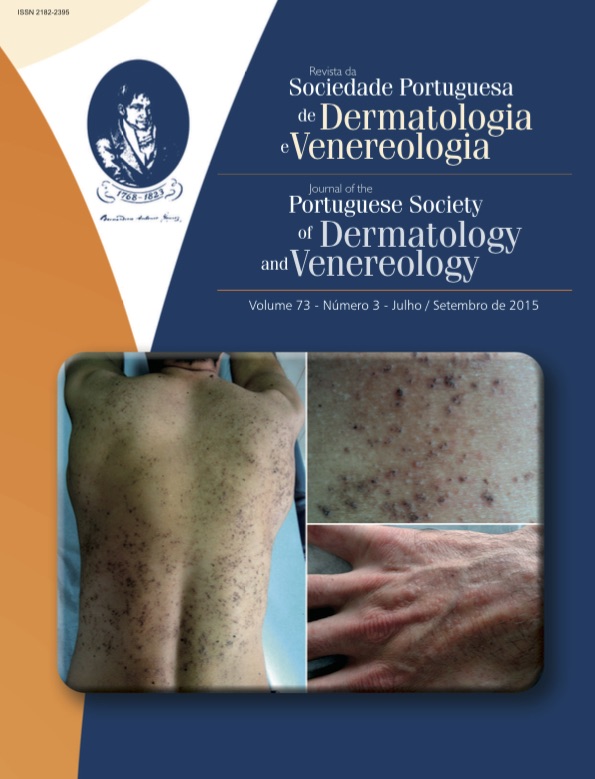PATCH TESTS UNDER SYSTEMIC IMMUNOSSUPRESSION – AN ABSOLUTE CONTRA-INDICATION?
Abstract
Introduction: Epicutaneous patch tests are the gold standard for the diagnosis of allergic contact dermatitis. Ideally, the tests should be performed without concomitant systemic imunossupression, which is not possible in some clinical situations. There are no guidelines on how to perform the tests or evaluate the results in such cases. We aimed to review the literature concerning patch testing under iatrogenic immunossuppression.
Material and methods: Literature review of Medline indexed publications related to the subject until January 2015.
Results: According to published data, patch testing was performed in 77 patients under systemic corticosteroid, 78 under cyclosporine (CyA), 6 under azathioprine, 10 under metothrexate (MTX), 4 under mycophenolate mofetil (MMF), 11 under anti tumoral necrosis factor agents and 7 under IL-12/23 inhibitor. Additionaly, 15 patients under association of immunosuppressors also underwent patch testing. Positive reations were observed in all groups.
Conclusion: Ongoing treatment with immunossuppressants should not be an absolute contra-indication for patch testing, as positive reactions can be elicited in patients treated with prednisolone, azathioprine, CyA, MTX, MMF, infliximab, etanercept, adalimumab and ustecinumab. Negative or doubtful results should be interpreted with more cautious.
Downloads
References
Rosmarin D, Gottlieb AB, Asarch A, Scheinman PL. Patch- testing while on systemic immunosuppressants. Dermatitis. 2009; 20(5):265-70.
Anveden I, Lindberg M, Andersen KE, et al. Oral prednisone suppresses allergic but not irritant patch test
reactions in individuals hypersensitive to nickel. Contact Dermatitis. 2004; 50(2):298-303.
Wentworth AB, Davis MDP. Patch Testing With the Standard Series When Receiving Immunosuppressive Medications. 2014:195-200.
Kim N, Notik S, Gottlieb AB, Scheinman PL. Patch Test Results in Psoriasis Patients on Biologics. 2014; 25(4).
Zollner TM, Igney FH, Asadullah K. Acute and chronic models of allergic contact dermatitis: advantages
and limitations. Ernst Schering Res Found Workshop. 2005:255-75.
Niiyama S, Tamauchi H, Amoh Y, Terashima M, Matsumura Y, Kanoh M, Habu S, Komotori J KK. TH2 immune
response plays a critical role in the development of nickel-induced allergic contact dermatitis. Int Arch Allergy
Immunol. 2010; 153(3):303-14.
Czarnobilska E, Jenner B, Kaszuba-zwoinska J, Kapusta M, Obtu K, Thor P. Contact allergy to nickel: patch test score correlates with IL-5, but not with IFN-gamma nickel-specific secretion by peripheral blood lymphocytes. Ann Agric Env Med. 2009;16(1):37-41.
Masjedi K, Ahlborg N, Gruvberger B, Bruze M, Karlberg a. Contact Dermatitis and Allergy Methylisothiazolinones elicit increased production of both T helper ( Th ) 1- and Th2-like cytokines by peripheral blood mononuclear cells from contact allergic individuals. 2003:1172-82.
Martins LE RV. Cytokine detection for the diagnosis of chromium allergy * Detecção de citocinas no diagnóstico de pacientes alérgicos ao cromo. J Eur Acad Dermatol Venereol. 2013; 88(5):719-25.
Olupona T, Scheinman P. Successful patch testing despite concomitant low-dose prednisone use. Dermatitis. 2007; 19:117-8.
Jackson S, Gilchrist H NLJ. Update on the dermatologic use of systemic glucocorticosteroids. Dermatol Ther. 2007; 20(4):187-205.
Feuerman E LA. A study of the effect of prednisone and an antihistamine on patch test reactions. Br J Dermatol. 1972; 86:68-71.
Wee JS, White JM MJ et al. Patch testing in patients treated with systemic immunosuppressive agents and cytokine inhibitors. Br J Dermatol. 2010; Conference 2:165-9.
Madan V GC. Systemic ciclosporin and tacrolimus in dermatology. Dermatol Ther. 2007; 20:239-50.
Vena G a., Foti C, Piazzola L, Angelini G. Can cyclosporin A help distinguish allergic from irritant patch
test reactions? Contact Dermatitis. 1994; 31:256-7. doi:10.1111/j.1600-0536.1994.tb01998.x.
Higgins EM, McLelland J, Friedmann PS, Matthews JN SS. Oral cyclosporin inhibits the expression of contact hypersensitivity in man. J Dermatol Sci. 1991; 2(2):79-83.
Flori L, Perotti R, Mazzatenta C AL. Cyclosporin A in the treatment of severe allergic contact dermatitis. J Eur Acad Dermatol Venereol. 1993; 2:200-6.
Flori ML AL. Patch tests after cyclosporin A treatment in hyperreactive patients. Contact Dermatitis. 1994;
(5):325.
Patel A, Swerlick R MC. Azathioprine in dermatology: the past, the present, and the future. J Am Acad Dermatol. 2006; 55:369-89.
Pigatto PD, Cesarani a., Barozzi S, Guzzi G. Positive response to nickel and azathioprine treatment. J Eur Acad Dermatology Venereol. 2008; 22:891.
Bangert C CM. Methotrexate in dermatology. Dermatol Ther. 2007; 20:216-28.
Zwerner J FD. Mycophenolate mofetil. Dermatol Ther. 2007; 20:229-38.
Rosmarin D, Bush M, Scheinman PL. Patch testing a patient with allergic contact hand dermatitis who is taking infliximab. J Am Acad Dermatol. 2008; 59:145-7.
Nosbaum A, Rozieres A, Balme B, Goujon C, Nicolas JF, Bérard F. Blocking T helper 1/T helper 17 pathways
has no effect on patch testing. Contact Dermatitis. 2013; 68:58-9.
Johansen JD, Aalto-Korte K, Agner T, Andersen KE, Bircher A, Cannavó et al. ESCD practical guideline on
diagnostic patch testing. Recommendations on best practice. Contact Dermatitis 2015 (in press).
All articles in this journal are Open Access under the Creative Commons Attribution-NonCommercial 4.0 International License (CC BY-NC 4.0).








